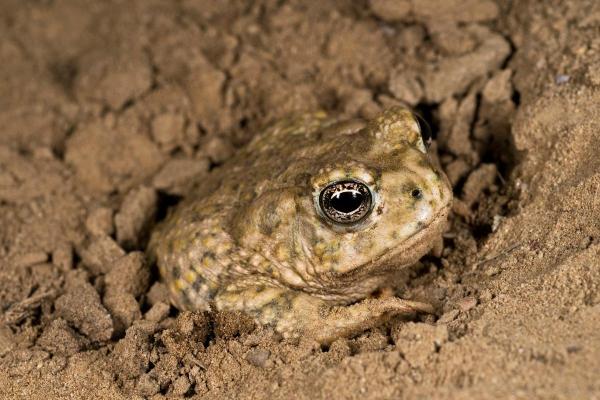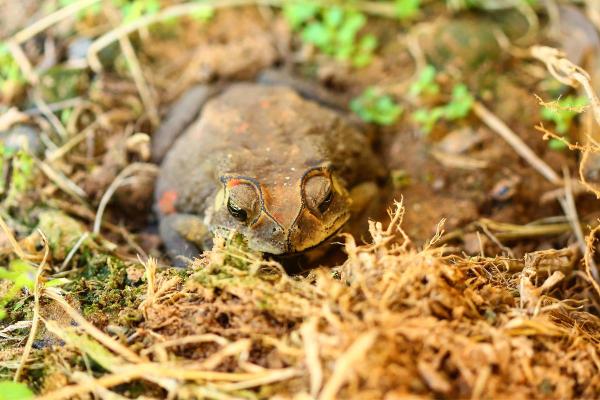How Do You Keep Toads Away Naturally


Toads can be surprising visitors in our gardens. While they gobble up pesky insects, some might find their presence unwelcome near patios, pools, or vegetable patches. The good news? There are humane and effective ways to encourage toads to explore elsewhere.
This AnimalWised guide will explore various strategies to gently deter toads from unwanted areas, prioritizing a healthy ecosystem and peaceful coexistence, all while keeping your specific needs in mind.
Identify the toad species
Many gardeners may initially consider repelling toads from their property. However, these amphibians play a crucial role in maintaining a healthy ecosystem by acting as natural pest control agents. Before implementing any toad control measures, understanding the local amphibian biodiversity is essential for effective garden management.
Researching the various toad species present in your area can provide valuable insights into their behaviors and ecological contributions. Some species are territorial, staying in a specific area, while others wander more freely. Knowing the species helps predict their movements and potential impact on your garden.
It's also important to note that a small number of toad species have mildly toxic skin secretions. This is why identifying the specific toad helps determine if there's any risk of skin irritation if you come into contact with them.
The good news is that not all toads are problematic. In fact, many species are beneficial pest controllers, consuming insects like mosquitoes and beetles. Identifying the species helps determine if they're actually a problem or a valuable contributor to your ecosystem.
In rare instances, however, deterring toads may be necessary. If this is the case, prioritize humane methods that minimize disruption to the ecosystem. Remember, maintaining a natural balance is key for a healthy garden.
Did you know toads and frogs have some key differences? Unlock the secrets of these amazing amphibians in another article on our site.
Habitat modification as a deterrent
Habitat modification offers a humane and effective strategy for deterring toads from unwanted areas. By adjusting environmental factors that attract them, we can achieve an ethical deterrence without harming the toads themselves. Here are some key strategies to consider:
- Water management: stagnant water sources are magnets for breeding toads. Eliminating these sources and improving drainage can significantly reduce their appeal to toads. Since toads are attracted to moist environments for breeding and hydration, managing water sources effectively can deter them. This includes fixing leaks, ensuring proper drainage, and avoiding overwatering in gardens.
- Light reduction: outdoor lighting attracts insect prey for toads. Minimizing nighttime illumination can naturally decrease the insect population, making your garden less attractive to toads.
- Strategic vegetation: while maintaining some vegetation provides cover for toad prey, pruning and tidying up can limit potential hiding spots for the toads themselves.
- Management of potential breeding sites: inspecting and removing temporary puddles or creating covers for existing water features can help deter breeding without harming toads.
By incorporating these habitat modifications into a holistic plan, you can foster a balanced ecosystem. This approach prioritizes coexistence with wildlife by addressing the needs of both your garden and the toad population.
Curious about what happens if your dog encounters a toad? We explore the potential risks and how to keep them safe in another article.

Use of physical barriers
To deter toads, consider employing physical barriers as an alternative approach. One effective method is to strategically place fences to guide toads away from specific areas. Additionally, wire mesh screens can be utilized around raised beds or vegetable gardens, serving as a barrier while allowing water flow and air circulation. Depending on the situation, other options such as strategically placed rocks or landscaping timbers may also serve as suitable deterrents.
When implementing barriers, it's crucial to ensure they stand at a height of 12-18 inches (30-45 cm) to effectively deter most toad species. Select materials that are sturdy yet non-harmful to toads, avoiding sharp edges or barbed wire. Opt for materials like wood, vinyl fencing, or hardware cloth.
Maintaining proper water drainage and air circulation in your garden is essential while deterring toads. Consider using mesh materials or leaving small gaps at the bottom of fences to prevent stagnant water pockets.
To prevent toads from burrowing underneath, firmly anchor the barrier in the ground. Smooth out any potentially sharp edges if using wood or other materials that may pose a risk of injury to toads. Regularly monitor the barrier's effectiveness and adjust its placement or materials as necessary.
Curious about the incredible changes some animals experience? Learn more about metamorphosis in another insightful article we have for you.

Natural repellents
Toads have a keen sense of smell, and certain scents can act as deterrents. However, it's important to note that these methods may have varying effectiveness and require reapplication:
- Vinegar: diluted vinegar solutions (1 part vinegar to 3 parts water) can be sprayed around the perimeter of the area you want to protect. The vinegar's acidity discourages toads.
- Citrus peels: the strong scent of citrus peels, like lemons, limes, and oranges, can be unappealing to toads. Scatter fresh or dried peels around the area you want to deter them from.
- Mint: the strong aroma of mint plants can also be a natural toad repellent. Consider planting mint around the edges of your garden or in pots near problem areas.
You can also utilize visual deterrents that exploit toads' natural instincts, such as:
- Predator imagery: while not always foolproof, strategically placing images or figurines of natural toad predators, like snakes or owls, might exploit their natural instinct to avoid danger.
- Reflective materials: the unexpected visual effects of strategically placed reflective surfaces, such as aluminum foil or reflective tape, might deter toads due to their altered perception of the environment. However, further research is needed to confirm its effectiveness.
Toads are primarily nocturnal creatures. Sudden or harsh changes in lighting might create an unsettling environment, making them less likely to stay in the area. Implementing short bursts of flashing or strobing lights can be a temporary deterrent. However, use caution to avoid disrupting the ecosystem or harming nocturnal wildlife.
Finally, one last approach to consider is auditory deterrence, which leverages toads' sensitivity to specific sounds. Devices emitting ultrasonic frequencies beyond human hearing range may offer a potential solution. Strategically placed, these devices could create a deterrent zone in specific areas of your garden.
However, it's important to note that the effectiveness and long-term impact of ultrasonic deterrents on toad behavior requires further research.
Other strategies
Beyond the methods already discussed, several additional humane strategies prioritize creating a less inviting environment for toads while ensuring their safety and ecological balance. These include:
- Encouraging natural predators: creating an environment attractive to natural toad predators like snakes or certain birds can help manage the toad population. However, this approach may not be suitable for everyone and might disrupt the local balance. Consider the potential drawbacks before implementing this strategy.
- Manual relocation: if toads have already entered the area you wish to protect, carefully capturing and relocating them to a suitable natural habitat away from your property is a direct and humane method. This should be done with care to ensure the toads are not harmed. Consult wildlife professionals for guidance if needed.
These strategies emphasize an ethical approach to managing toads, prioritizing their safety and the preservation of the ecosystem.
Curious about the differences between toads and their reptilian neighbors? Dive deeper into the fascinating world of cold-blooded creatures in another article.
If you want to read similar articles to How Do You Keep Toads Away Naturally, we recommend you visit our Facts about the animal kingdom category.
- Davis, J.L., Alford, R.A., & Schwarzkopf, L. (2015). Some lights repel amphibians: implications for improving trap lures for invasive species . International Journal of Pest Management, 61(4), 305-311.
- Narayan, EJ, Forsburg, ZR, Davis, DR, & Gabor, CR (2019). Non-invasive methods for measuring and monitoring stress physiology in imperiled amphibians . Frontiers in Ecology and Evolution, 7, 431.
- Soto-Azat, C., Clarke, B.T., Fisher, M.C., Walker, S.F., & Cunningham, A.A. (2009). Non-invasive sampling methods for the detection of Batrachochytrium dendrobatidis in archived amphibians . Diseases of Aquatic Organisms, 84(2), 163-166.







